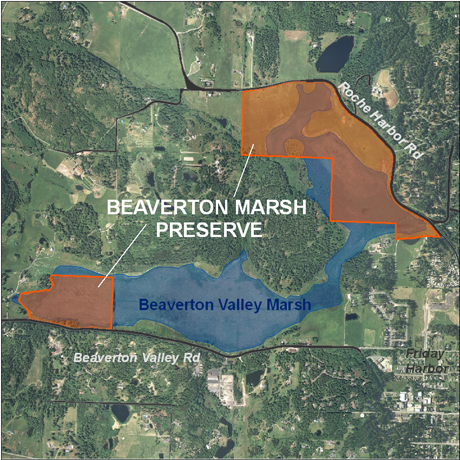The restoration of the Beaverton Valley Marsh is underway….
Posted September 20, 2010 at 5:13 pm by Ian Byington
Here’s more from Judy at the Land Bank:
Beaverton Valley Marsh Restoration is Underway
The San Juan County Land Bank is leading partners in an effort to protect and restore Beaverton Valley Marsh, the largest wetland complex in the county at over 250 acres. The latest achievement in this project was the acquisition in September 2010 of 40 acres of land at the western end of the marsh, plus a 3.5 acre conservation easement. The Land Bank intends to resell the 40-acre tract to the San Juan Preservation Trust and retain an easement on that area as well.
In 2001, the Land Bank made its first purchase in Beaverton Valley Marsh – 128 acres of farmland and wetland along Roche Harbor Road across from Sutton Road – now known as the Beaverton Marsh Preserve. More land was added to the preserve in 2002 and 2006. The non-profit wetlands conservation group Ducks Unlimited has secured federal grants to pay for the Land Bank to do even more land protection in the marsh, as well as wetland restoration. Beaverton Marsh Preserve is also a good candidate for future public access; the Land Bank is currently evaluating the feasibility of primitive trails for walking and wildlife viewing
The Land Bank will embark on the first phase of restoration this fall and winter. Native shrubs and trees will be planted along the margins of the wetland at the Beaverton Marsh Preserve, in areas currently covered with the non-native invasive plant reed canarygrass. Establishing an array of native species should, over time, enhance the wetland’s diversity and improve its habitat value for migratory songbirds, amphibians, and other wildlife. There will be opportunities for public participation this November and December when the Land Bank will host a series of rain-or-shine interpretive and volunteer planting events in the marsh.
Prior to being cleared and drained for agriculture over a hundred years ago, Beaverton Valley Marsh was probably a mixture of different wetland types, including shrub and forested wetland, aspen stands, and rare sphagnum bog habitat. Today it is dominated by reed canarygrass, an aggressive, invasive plant that excludes most other species. Drainage ditches have not been maintained for decades, and much of the land has fallen out of agricultural use, with the exception of some summer grazing and haying. With the agreement of neighboring land owners, future restoration actions may include plugging old drainage ditches or installing a water level control structure at the outlet of the marsh. These actions would return water levels and hydrology to approximately their historic conditions.
Restoration of the marsh can also be tailored to fit individual landowner’s desires. For example, carefully managed seasonal grazing can create good habitat for winter waterfowl use. Alternatively, replacing non-native grasses with native plants is good for habitat diversity and complexity, and benefits a different array of species. Other general benefits of restored wetlands include improved water quality, flood control, and ground water recharge.
Contact the Land Bank at 378-8240 for more information about the project and about volunteering later this fall.
You can support the San Juan Update by doing business with our loyal advertisers, and by making a one-time contribution or a recurring donation.
Categories: Enviro Corner











No comments...
Trackbacks
By submitting a comment you grant the San Juan Update a perpetual license to reproduce your words and name/web site in attribution. Inappropriate, irrelevant and contentious comments may not be published at an admin's discretion. Your email is used for verification purposes only, it will never be shared.